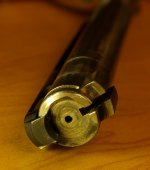fishoot
Plastic
- Joined
- Mar 10, 2007
- Location
- Folsom, California
A friend of mine dragged me into the world of chambering a belted magnum case for a coned breech rifle. My experience to date has been mostly mausers with a smattering of other actions but mostly breech faces without a cone. The 1917 enfield we are chambering has given us fits. We cut a chamber and extractor cut in one attempt to find that we had very little belt inside the chamber. Thinking of the horrors of too little case support, we turned off a thread to time our previously made extractor cut (.100") and cut another chamber. As we formed the shoulder and cone we put marking fluid on the bolt face and watched for transfer rubs on the coned breech and nose of the bolt. When everything seemed right we started reaming the chamber. All went well, but when we got the go gauge dimension correct, we only had about .020" of the belt inside the belt cut of the chamber. Chamber drawings I have seen only show the belt to case head dimension and do not show detail on how much of the belt is enclosed in the chamber. So the question is, how much of the belt has to be enclosed in the chamber to be safe? We have had some preliminary feedback indicating that the web of cartridge case is adequate if the belt is enclosed minimally because the web is strong enough in the case. Others think that most of the width of the belt should be almost fully enclosed in the chamber. Any advise on this would be appreciated.


